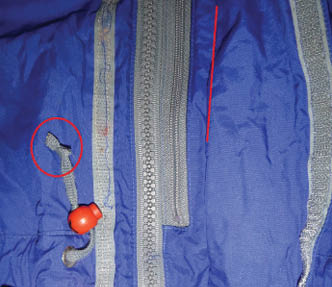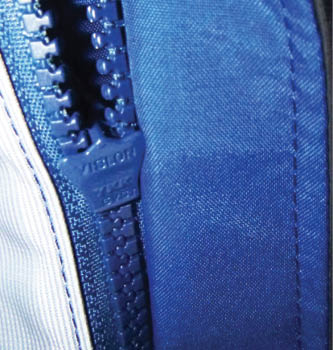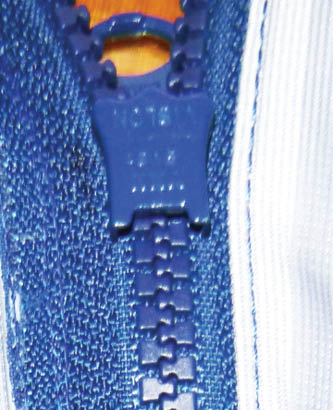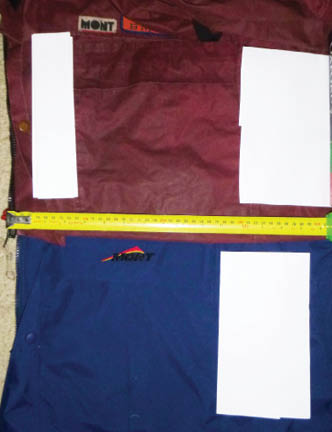



Mont™ is a long-established Australian company making bushwalking and related gear. In mid-2017 I bought a Mont™ Austral blizzard jacket. The following is a review of that jacket.
The Austral jacket is from the Mont™ website and shows a colour called ochre
Mont Austral Jacket Review
Stephen Lake

64 | BWA April 2018


BackgroundFirst, some terminology. I use the form of words “blizzard jacket” to describe garments designed to be worn outdoors as protection from bad weather. This term was adopted 20-30 years ago to avoid confusion with a jacket that keeps the wearer warm. In a bushwalking context where the use is understood, abbreviating this to “jacket” make sense, and this has been done below.
Many years ago there was only one sort of jacket – oiled japara. The basics of this garment remain in today's jackets: a hood, wrist cuffs, and patch pockets on the front. Over time, refinements have been added: wire in the hood, drawstrings at the hood and waist, a map pocket, two way zips, and more.
One relatively recent development has been the jacket length. Where once all jackets went to the mid-thigh or knee, now the vast majority of jackets end at the waist or a little lower. There's a thread discussing jacket length.
Some extracts from the thread“Depends on how the "clothing system" is configured. We now have convenient and comfortable waterproof and quick dry pants, waterproof packs etc, the requirements on the jacket are very different now than those years when rain and weather protection were largely dependent on the sole jacket.” GPS Guided
“At least below the bum would be nice. Women's jackets tend to be shorter than men's from many manufacturers ... apparently we think looking fashionable and showing off our waistline is more important than staying warm and dry." Eremophila
“(I prefer) long. Mid-thigh at least. I do have a short OR jacket but only use it for fairly gentle rainforest type walking. The length is even more important with the current fashion for hipster style rainpants. Even without a pack you get a draft up the back whenever you move, especially bending over.”NNW
“In reality a lot of customers are only using the gear to walk in the park or around town because its now fashionable to wear those designs in the city. They aren't cut for fit people but for the average well endowed westerner. If there's decent rain those people are less likely to be outside”.Wayno
In the above thread there's a preference for longer jackets, and I subscribe to that view. I rarely carry or wear overpants; a long jacket usually suffices. So it seems that short jackets are made more than long jackets due to fashion as perceived by the manufacturers and the possibility of wearing overpants.
There's not many long jackets in the shops. When I bought my jacket Mont™ had two jackets, Tempest and Austral, quite similar. Apart from the more expensive fabric in Tempest, the differences are slight and I could not see value in the more expensive Tempest. I decided on an Austral. There's four colours and I bought blue, mainly due to the shop only having blue.
The Austral material is Hydronaute, which seems to be like Gore-Tex. Manufacturers love to have proprietary brands for items or designs that are very similar to other well known items or brands.
1 FlapThe Austral double studded flap covering the zip does not appeal; pressing studs in poor weather while wearing gloves could be hard. One option is to remove the studs and sew hook and pile (often referred to as Velcro®) to the two flaps. The studs do not make the flaps very water resistant – there are big gaps. Hook and pile is better and easier to secure. I'm considering removing the studs and sewing hook and pile as a trade-off, but the hook and pile stitching would leak. Maybe put hook and pile between the studs. A glue-backed hook and pile would be good.
Mont™ said: "Studs were used after significant feedback indicating Mont™ Austral users would prefer studs. Studs do not attract grass, seeds, fluff etc like hook-and-loop does."
BWA April 2018 | 65
I was slightly amused to see quite different current Mont™ designs for garments that do the same job. If a design is good then it should be used in all garments that are for the same purpose. Tempest has been discontinued and there's a new model, Odyssey. The main variations to the Austral are that the fabric is said to be better than that of the Austral, there are no flaps over the main zip, and there are zips under the armpits. It is unclear if the Odyssey fabric makes much difference. Interestingly, the flap behind the Odyssey zip does not jam like in the Austral. I would rather have flaps over the zip than behind. The Odyssey costs $600. I’m not persuaded that paying $200 more than the Austral is indicated.
2 Internal zip flap design One aspect I noticed before buying was that the Austral had a flap behind the zip, apparently to stop water coming in. This is a poor design: the flap catches on the zip, and the flap is probably unnecessary as there's two flaps with studs on the outside. I asked Mont™ if they could have a special jacket made for me with no flap. Not possible. I then said that I would think about removing the flap.
Mont™ said: "Care must be taken when doing up the zip to ensure inner storm flap is not caught."
True, but the flap is pushed onto the zip, making it very hard to avoid the zip catching the flap.
With difficulty I removed the flap and zip; the stitching is very tight, and the taped seams made it quite hard to unpick the zip and flap. Once the first few stitches were unpicked the rest was relatively easy. The zip was sewn back. When I was doing this I realised that the flap was pointless. The flap is not enclosed, and once water is past the zip it spreads inside. A better design is to stop water going into the zip.
Mont™ said that the internal flap prevents "extensive water from reaching the inside of the garment if it wicks down the zip" and that this is "extremely rare".
This advice accepts that the outer flaps do not work. I tested this as follows. The jacket was dry, zip done up, outer flaps open, vertical. I used a hand-action spray to put water on the zip. After four pumps water was detected inside the zip. If the internal flap was present the water would simply escape to the side.
Without the flap the zip did not catch, and I'm quite happy with the result. The pictures (below and on the next page) show why the zip caught on the flap before I removed it, and how it's much better after the repair.

A Cats and Dogs jacket showing the cord gripper hard against a knot with a second knot at the end, in the red circle, making it easy to grab and use. The map pocket zip in the middle is under the deep storm flap folded back on the right. The flap has never jammed.

Zip catching on the inside flap before it was removed
66 | BWA April 2018
One major cause of the jam was the seam taping. The tape is quite stiff and pushes the fabric so that it catches on the zip. Ultimately though the cause is poor design. I've had many jackets over 50 years of bushwalking and none jammed like the Austral. I've seen flaps next to zips with a light stiff tape, which do not catch in the zip.
The J&H Cats and Dogs zip flap design is simpler and easier to use.
3 The zipI prefer a zip that's bigger than the Austral's YKK 5. A YKK 8 is on other brands; easier to start, runs a bit smoother, less likely to jam. My Cats and Dogs has a YKK 10, nice and chunky, always worked, even after over 20 years of use. Mating the two halves of the Austral zip at the bottom was tricky. About half the time this did not work. When the zip worked it was fine.
Mont™ explained how to operate a zip, and said that "The zip will work when engaged correctly."
Problem is that mating the two halves was tricky. I know how to use zips, and the lack of zip functionality is unique to this jacket.
4 Patch pocketsThe patch pockets are badly sited in that they are immediately adjacent to the zip, which makes it somewhat hard to put the hands in the pockets. Either the pockets should be 80-120 mm further from the zip, wider, or the top should be at an angle. My Mont™ dry japara jacket is perhaps 20 years old, with pockets that are a similar size to those on the Austral, but are further from the zip, much better. A Cagjac perhaps, 30 years old, has patch pockets starting at the zip, 320 mm wide, very easy to access, easily holds a map. I'm attempting to work out what to do about the Austral patch pockets. Moving them involves major surgery, and as I cannot easily use the pockets I may just cut them off, save a bit of weight.
Mont™ said that "They are positioned based on extensive field testing and first hand experience of Mont™ designers."
It is an ergonomic fact that patch pockets are better better placed more to the side and/or have angled entries.


The Mont™ dry japara and Austral jackets showing the placement of the patch pockets, marked by white paper on three sides. The Austral pocket starts at the zip. Both zips are on the left of the picture.
After the internal flap was removed there were no jams
BWA April 2018 | 67
5 DrawstringsThe waist drawstring is very badly designed, The ends are inside the patch pockets, so to adjust the cord grippers the pockets must be opened, letting in water when it's wet. Being in a corner of a pocket does not assist. The awkward access to the pockets means that it's a little hard to find the ends of the cords, which become tangled with pocket contents. Wearing gloves compounds the problem. Further, the cord goes through 90 degrees at the ends, and jams badly. This sharp turn puts a lot of pressure on the last stitch and the fabric near this. Good garment design shares the load over several points. With the higher pressure there's a much higher chance of a stitch creating a hole here. I like to have a partial elastic waist cord. The jacket does not have this and it's impossible to replace the cord, so if the cord breaks (unlikely) there's no easy way to replace it. Not good.
Mont™ said that "Positioning the cords inside the garment reduces snag points. Market demands also required a "cleaner" look for the jacket."
The points I made were not denied. I've had no problems with snag points on other jackets. Functionality has been sacrificed for fashion.
The Mont™ dry japara jacket has a much better arrangement where a simple tube is sewn inside the jacket. This would be faster and easier to make than the Austral setup, and it's very easy to thread a new cord in the dry japara jacket. My Cats and Dogs has a good design, with cord grippers on the outside. This jacket is 22 years old, and the eyelets are intact. Note the double knots, allowing the cord grippers to stop at one knot while the wearer grabs the other one. I'm attempting to find a way to fix the Austral waist drawstring design. One option is to unpick the ends of the Austral cord sleeve and put in eyelets at each end, with the cord on the inside or outside of the jacket. There's never been a problem with the Cats and Dogs flapping cords. Or the ends of the Austral cord sleeves could be unpicked with stitching to narrow the gap and reinforcing to make it wear better, cords on the outside.
The Austral hood drawstring has cord grippers that are flush with the material due to a short sleeve. It seems that the sleeve is designed to stop the cord flapping, and this works. However, in cold weather, grabbing the cord and cord gripper would be hard. This was fixed by removing the small plastic grips at the ends, pulling cords out of the sleeve, and knotting cords. This worked well.
Mont™ said: "User feedback indicated customers would prefer lighter weight and more compact hardware on jackets."
This does not comment on the point I made. The gripper is fine but the flap adds weight and compromises functionality in that the gripper and end are hard to grab.

The hood gripper arrangement. The white cord shows where the hood cord was, under the flap. Note the gripper was in a very tight place, hard to grab. The gripper cord had to be taped to keep it in frame.
68 | BWA April 2018
6 Map pocketThe map pocket is on the outside and does not work very well. A comparison between the Cats and Dogs and the Austral is set out next.
Jacket
Zip length
Pocket width
Pocket depth
Area
Cats & Dogs
290 mm
270 mm
325 mm
870 sq cm
Austral
175 mm
210 mm
305 mm
640 sq cm
The Cats and Dogs has a much better map pocket design than the Austral. In particular, the Austral zip is far too short for anything except a map that is folded to a small size. The Cats and Dogs will take bigger maps and it's easy to put maps in and take them out, much better.
Mont™ said: "This pocket is a generous size chest pocket and can be used for many things … Perhaps for maps it is a little small, but we would suggest using a map case."
The word "generous" is interesting. I want a pocket big enough for maps, and the Austral size is much smaller than the Cats and Dogs. With gloves a bigger person would struggle to use the map pocket – the zip is simply too small.
7 CuffsThe Austral cuffs and hood have hook and pile flaps extending to the very end of the flap. When I make these sort of flaps I have the hook or pile stop about 15 mm from the end of the flap, and at the end sew a small roll of fabric, making it easier to grab the flap while wearing gloves.
Mont™ said: "Recessed tab seams are not appropriate in laminated construction as it interferes with the adhesion of the lamination."
The sleeves are rather long, which I like as this means that in bad weather the hands can retreat under cover.
SummaryThe Mont™ Austral has several major design flaws. The designs of the Mont™ dry japara jacket and the J&H Cats and Dogs of about 20 years ago are much better. The Austral design could easily be improved, which would make the jacket a little lighter, much better, and cost less. If there was another long jacket for a reasonable price, I'd buy it. However, the Australian range is very limited, another victim to fashion at the expense of many bushwalkers' needs. Mont™ should consider a smaller range with one design, which would assist in keeping costs down at all levels of the supply chain and for inventory. This would also make the price lower. I bought the jacket because it was the only one I could find that seemed to work. I don't mind removing the zip flap and accept a few other minor flaws. The zip is still hard to use, too small in my view. I did not realise that the patch pockets were so badly placed or that the map pocket was so small. I would not buy this jacket again – it lacks basic functionality. I'll keep using it but if I can find a better one I'll buy that, and regretfully write off the $400 I paid for the Austral to experience. Anybody want to buy a modified Austral?
Mont™ said that "The Austral jacket is one of our most successful garments and has been a key part of our bushwalking range for more than two decades. … Continual product improvement is the ethos that underpins all design work at Mont™. We consider all aspects of product performance, utilising decades of design experience, a robust field testing regime, and, as mentioned, a strong regard for customer feedback."
Stephen has worked in textiles, including quality control and writing clothing specifications. He has been been designing, making and repairing bushwalking gear for many years. A pack he made in 1976 is still in use. One sewing expert commented on his sewing skills along the lines of “I have never seen anything like that before.” Quite.

BWA April 2018 | 69